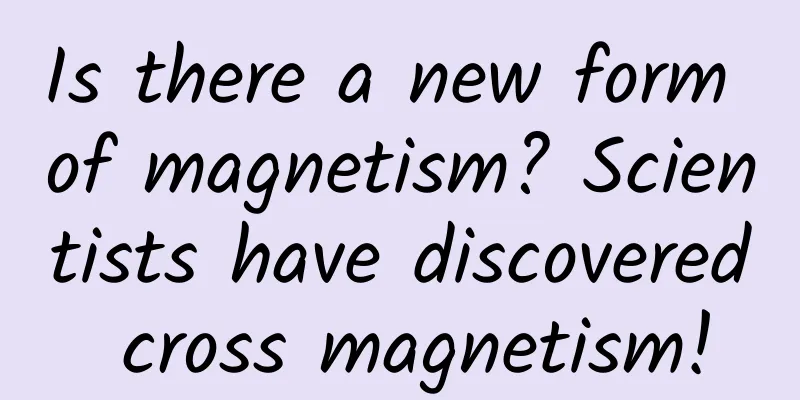Is there a new form of magnetism? Scientists have discovered cross magnetism!

|
Li Zhaoying Magnetism is a concept that we are very familiar with in our daily lives. According to different arrangements of magnetism, there are theoretically 1421 types of magnetism, and many types have been discovered experimentally. On February 14 this year, a new study published in the journal Nature showed that scientists have confirmed the existence of a new form of magnetism - altermagnetism - through experimental measurements for the first time. To understand what staggered magnetism is, let's start with the most familiar ferromagnetism and antiferromagnetism. Ferromagnetism and antiferromagnetism The magnets we come into contact with in daily life, such as refrigerator magnets and door stoppers, are all ferromagnets, and their magnetism is called ferromagnetism. The magnetism of a material mainly comes from the behavior of its internal electrons. From a microscopic point of view, each electron is like a small bar magnet. The direction of the electron's magnetic moment is directly related to its spin (that is, the electron's intrinsic magnetic moment). Whether an atom has a magnetic moment is closely related to the distribution of electrons. If the electrons in the same orbit of an atom are paired, the principles of quantum mechanics will make their spins in opposite directions, so the magnetic fields generated by their respective magnetic moments can cancel each other out. This results in the atom itself not having a net magnetic moment, so the material composed of these atoms will not exhibit ferromagnetism as a whole. However, there are atoms of some elements, such as iron, nickel, cobalt, manganese and most rare earth elements, whose atoms have many unpaired electrons in their outermost layers. Once the spins of these electrons are aligned in the same direction, a weak magnetic moment will be generated, that is, the net magnetic moment of the atom is not zero. In addition, the orbital motion of electrons inside the atom will also generate a magnetic moment, but it is generally much smaller than the spin magnetic moment. The overall magnetic moment of the atom is the result of the coupling of the spin magnetic moment and the orbital magnetic moment. Under a specific temperature environment, the magnetic moment of the magnetic atom will form small magnetic domains inside the material, which is equivalent to a larger-scale magnet. If the arrangement direction of these magnetic domains is also consistent, it will cause the material to have a relatively large magnetic field as a whole, making the material exhibit ferromagnetism. Ferromagnets have many practical technological applications, such as being used as computer magnetic storage units, because the spins of electrons in ferromagnets can be flipped by applying an additional magnetic field, resulting in different magnetic and non-magnetic states, recorded as "1" and "0". This strong spin correlation in ferromagnets has also given rise to a research field known as spin electronics. Unlike traditional electronics research that only considers the charge of electrons, spin electronics devices also use the spin state of electrons to carry more information. For a long time, people equated magnetism with ferromagnetism. But in the 1930s, physicist Louis Néel and others discovered another type of magnetism, antiferromagnetism. In antiferromagnets, the magnetic moments of atoms do not all point in one direction, but alternate, with the magnetic moments of the two nearest neighboring atoms being equal in magnitude and opposite in direction. Therefore, at the macroscopic level, the magnetic fields generated by the internal magnetic moments of antiferromagnets will cancel each other out, and there is no obvious macroscopic magnetic field effect, so refrigerator magnets made of this material cannot be stuck to the refrigerator. Scientists have also conducted a lot of research on the application of antiferromagnets in the field of spin electronics, but there are not many practical applications yet. Staggered magnets A few years ago, physicists were looking for antiferromagnetic materials when they stumbled upon a strange compound, ruthenium dioxide. Ruthenium dioxide has no net magnetic moment, which is almost the same as antiferromagnets whose spins are arranged alternately; but at the same time, when there is an electric current, this material behaves like a ferromagnet. Scientists have confirmed this property of ruthenium dioxide through experiments. In 2021, scientists came up with an idea to get a material that is somewhere between ferromagnets and antiferromagnets. In simple terms, their solution is that instead of imagining that the spin magnetic moments of these atoms are connected to the atoms themselves, it is better to imagine that the spin magnetic moments can rotate independently of the atoms themselves, so that operations can be performed on this material that still maintains the same magnetic structure. In such a material, the spin magnetic moments can still be arranged alternately, but because the orbits of the atoms themselves are weakly coupled to the spins, the atoms themselves can be considered to be able to rotate further. We can give a simple example to illustrate this situation: if you rotate every other atom in a ferromagnet by 90 degrees, and then flip the spin magnetic moments of these atoms by 180 degrees, the result will become - if you look at the spin magnetic moment, it looks like an antiferromagnet, but if you look at the way the electrons move inside the material, they prefer to move along the direction of the atoms with the same "orientation", so it actually looks more like a ferromagnet. It's not just ruthenium dioxide, there's actually a whole class of materials that can exhibit this kind of magnetism, which can be called staggered magnetism. The properties of most magnetic materials depend on whether the magnetic field of each atom (represented by its spin) points upward (pink) or downward (yellow). In staggered magnets, the spins of atoms and electrons rotate independently, giving them properties of both ferromagnets and antiferromagnets. In 2022, theorists predicted more than 200 possible candidates for staggered magnets from various insulators, semiconductors, and metals. Many of these materials were known in the past and have been extensively studied, but no one has noticed their staggered magnetic nature. Since staggered magnets have great application potential, researchers have begun searching. Manganese telluride In the recent study, the researchers focused on a simple crystal, manganese telluride, a binary material that has long been considered a classic antiferromagnet because the magnetic moments of neighboring manganese atoms point in opposite directions, thus generating no external magnetic field around the material. In a photoemission experiment, they manipulated the polarization direction of the "light" "irradiated" on the manganese telluride crystal according to theoretical predictions. They measured the band structure of the material based on the angle-resolved photoelectron spectrometer of the synchrotron radiation facility to further understand the electron energy and momentum distribution characteristics in the crystal. Then, they found that despite the absence of an external magnetic field, the electronic state in manganese telluride still exhibited strong spin splitting, and this spin splitting was completely consistent with the results of staggered magnetism predicted by quantum mechanics calculations. In other words, the new research proves that manganese telluride is neither a typical antiferromagnet nor a typical ferromagnet, but an alternating magnet with different spin magnetic moments and atomic orientations. Or will lead a technological revolution The discovery of staggered magnets has huge implications for spintronics. This field is growing, and several other studies have recently emerged that confirm various other properties of staggered magnets. Therefore, the discovery of staggered magnetism may just be the beginning of an exciting new era in magnetism. Paper link: https://www.nature.com/articles/s41586-023-06907-7 This article is a work supported by Science Popularization China Starry Sky Project Author Name: Li Zhaoying Reviewed by: Luo Huiqian Produced by: China Association for Science and Technology Department of Science Popularization Producer: China Science and Technology Press Co., Ltd., Beijing Zhongke Xinghe Culture Media Co., Ltd. |
<<: I really want to ask: My partner has a very loud voice, will it damage my hearing?
Recommend
Summary of the channel characteristics of advertising on Momo, iQiyi, Kuaishou, etc.!
What are the characteristics of information flow ...
How to do short video marketing? What are the short video marketing techniques?
Now that short videos have become the traffic ent...
How to operate and promote App without experience? You need to understand this knowledge
Some people say that if you want to be a great pe...
Experiments to ignite user growth: A/B testing best practices
In order to achieve scientific growth in the seco...
Starting as a "temporary worker", how did Airlock transform into a "business elite"?
Currently, Chinese astronauts are using the Wenti...
How do brand accounts on Bilibili attract fans and traffic? How do UP hosts on Bilibili get paid for promotion?
Advertising is becoming a new engine for Bilibili...
The World Health Organization announced that it will be completely eradicated by the end of 2023! All about its files and "crimes" are explained at once
Image from: freepik.com Recently, the World Healt...
KGI Securities: The worst is over for Apple iPad
KGI Securities analyst Ming Jiguo released his la...
Why is there negative growth in telecom users?
According to China Telecom's performance, the...
How do we “see” the brightest “fireworks” in the universe?
On October 9, 2022, there was a very shocking and...
Plants can actually give birth to live young. Seeds float on water, so there's no need to worry if they fall into the sea!
People who have never seen mangroves must think t...
Complete success! A photo review of the interstellar bridge "Queqiao-2"
The National Space Administration announced on Ap...
How to bid Baidu CPC/oCPC? Big Search Delivery Guide
There are two ways to bid for big searches now: t...
Do you catch a cold when the season changes? Be alert if you have these 5 symptoms
The weather has turned cold recently. In addition...
National Hepatitis Day丨How does your liver become overdrawn step by step?
The cover image and the images in this article ar...









